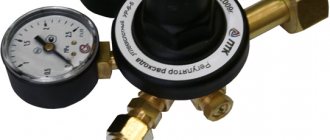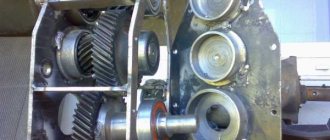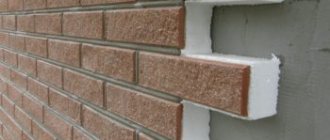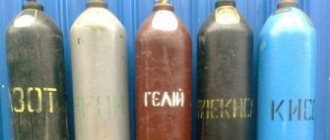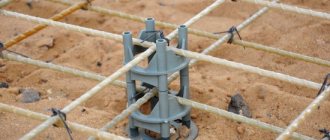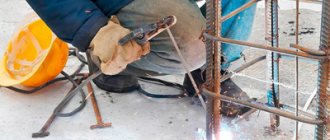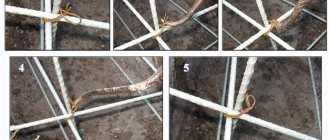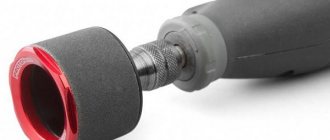Gearbox with rotameter
Increased functionality (compared to gearboxes) is provided by carbon dioxide flow regulators with a rotameter. Unlike traditional pressure gauges, for which the flow rate must be set depending on the current pressure, rotameters show the flow rate immediately. Universal flow regulators, which include rotameters, greatly facilitate the work of the welder and allow optimizing the consumption of carbon dioxide during welding. The issue price is from 1800 to 2000 rubles. The technical characteristics of the regulators - flow, pressure, temperature range of use - must correspond to the required welding modes.
Regulators differ from conventional gearboxes in the following ways:
If in gearboxes the outlet fitting is connected directly to the main line, then the regulator is equipped with a special damper that throttles the flow of CO2, depending on the gas pressure in the cylinder. The hole in the throttle is calibrated, which increases the accuracy of flow adjustment. Therefore, most models of regulators are equipped with one pressure gauge, the readings of which are set not in pressure units, but in flow units. Some regulators provide built-in electric gas heating. This allows welding to be carried out at subzero temperatures, and increases the accuracy of determining the actual gas flow rate (in gearboxes, the flow rate, as a rule, cannot be adjusted to a different value). Regulators for semi-automatic machines can be installed not only on a cylinder with liquefied carbon dioxide, but also on so-called mixed cylinders, which contain a mixture of carbon dioxide with an inert gas, in particular argon (in a ratio of 1:4).
When choosing the standard size of a carbon dioxide gearbox, pay attention to such design features as the design of the adjusting screw and the presence of a captive thread on it (otherwise you can unscrew the seat), as well as the presence of an additional shut-off valve
The quality of the gas is also important: food-grade carbon dioxide has low humidity, so the inside of the cylinder does not rust
What to choose
It is believed that for domestic welding conditions - short-term, occasional operations - any device that matches the thread of the cylinder is suitable.
Even a carbon dioxide reducer screwed onto an oxygen cylinder (if gas welding is used) or onto a cylinder for a welding mixture of 80% argon and 20% carbon dioxide can withstand an operation like welding a barbecue for a summer house. Another thing is that later this mechanism will have to be thrown away.
A typical example of such a gearbox designed to work with CO2 is the very well-known and popular among old-school welders UR 6-6.
It is compact, inexpensive, and thanks to the presence of two pressure gauges, it makes it quite convenient to determine the flow rate “by eye.” For household welding, high precision is not needed. One pressure gauge shows the residual pressure in the cylinder, and the second is aimed at demonstrating gas flow - liters per minute.
Oxygen and argon welding regulators are theoretically interchangeable. In this case, oxygen will work worse as the pressure in the cylinder drops to a critical point of about 1 atmosphere.
An example of an argon gearbox for welding is the domestically produced AR-40-2. There is also a truly universal pressure regulator - AR-40/U-30 (argon reducer/carbon dioxide). It will withstand both temperature changes and high pressure.
If there are no financial restrictions, and the volume of welding work is expected to be high, then you should prefer a device not with an additional pressure gauge, but with a rotameter.
The rotameter shows the flow rate of the gas mixture much more accurately, since it works on different principles - it takes measurements in real time. These devices are used by professionals.
Source
What is the difference between an oxygen reducer and a carbon dioxide reducer?
The designs of carbon dioxide reducers are very similar to oxygen ones, and differ mainly in the methods of connection to the valves, and - sometimes - in the absence of a second pressure gauge. Therefore, the question often arises: are oxygen and carbon dioxide reducers interchangeable?
Much higher performance requirements are placed on the oxygen reducer. They are due to the fact that, unlike CO2, oxygen is not liquefied, and therefore is in the cylinder under much higher pressure (up to 200 atm versus 70...80 atm for liquefied carbon dioxide). Therefore, when oxygen enters the carbon dioxide reducer, the sealing membranes will gradually destroy. Therefore, the carbon dioxide reducer is not used to supply oxygen (reverse replacement is acceptable).
The gearboxes also differ in the possibilities of connection options to the cylinder. The carbon dioxide reducer can be connected using a clamp rather than a union nut, since CO2 does not have fire or explosion properties in case of leaks.
To improve the purity of the gas entering the reducer, cleaning filters are often included in the inlet valve design. The presence of a filter reduces the risk of gas venting back into the cylinder, where it can form a surface cushion over the liquefied gas.
https://youtube.com/watch?v=HJK7hbwLk34%3F
Is interchangeability possible?
Some types of welding gears are interchangeable, but not all. So, instead of a specialized CO2 reducer for welding, it is permissible to use an oxygen one, but a reverse replacement is absolutely forbidden.
Oxygen is a chemically active substance, a strong oxidizing agent, so special metals and alloys are used to work with them. In addition, oxygen is pumped into gas cylinders under pressure that exceeds the same parameter for carbon dioxide by more than 2 times.
A welding reducer for carbon dioxide screwed onto an oxygen cylinder can last, depending on its quality, from several hours to a couple of weeks. But the sealing membranes, the main structural element, will inevitably be completely destroyed, as a result of which the device will begin to etch.
To avoid erroneous actions by the welder, different threads are made on gearboxes for flammable and non-flammable gases. For flammable - left, for non-flammable, respectively, right.
Similar threads are found in cylinders for cutting and welding. In this case, the oxygen reducer has a right-hand thread. Oxygen does not burn on its own, but supports combustion. It is explosive under certain conditions.
The oxygen reducer used during welding with a carbon dioxide cylinder faces another threat. Carbon dioxide causes parts in contact with it to freeze to -60 °C. Since the pressure regulator designed for oxygen is not supposed to withstand this operating mode, it will also begin to deteriorate.
Color coding
Essentially, a reducer is a pressure regulator. It is a mandatory part of the equipment for semi-automatic welding machines that use the principle of welding in a protected gas environment. At least two reducers (each to its own cylinder) are used in.
Of course, the best solution would be to choose only a reducer specifically designed for it for a cylinder with a certain gas. There is a strict color coding system:
- blue color with black inscription - oxygen;
- white with red text - acetylene;
- black with blue inscription - technical argon;
- black with white lettering - raw argon;
- black with yellow inscription - carbon dioxide (CO2).
Depending on whether you use gas welding, argon arc welding or carbon dioxide welding, choose the appropriate gearbox.
At the market or in a store, this can be easily done by color - the color of the welding gear matches the color of the cylinder for which it is intended. Blue is for oxygen, black is for argon (also suitable for carbon dioxide), and so on.
general information
In general terms, a reducer is a device that reduces the pressure in a gas cylinder. It is installed directly on the cylinder and is necessary every time you use a semiautomatic welding machine, if you generally weld in a protective or inert gas environment. Often two cylinders are used, each of which must have its own reducer installed.
Each type of gas has its own reducer. For your convenience, the device is marked with a specific color, which indicates the purpose of the gearbox. If the reducer is marked in black with a yellow inscription, it means it is intended for carbon dioxide (aka CO2 reducer). If the background is blue and the inscription is black, it means for oxygen. White markings and red signature - acetylene. And black markings with blue or white inscription are intended for acetylene or argon, respectively.
Another way to recognize the reducer you need is to remember the color of the cylinder. After all, it is also marked using color. For example, a black cylinder is often used for argon, a blue cylinder for oxygen. And so on by analogy with other colors.
Design and principle of operation of a carbon dioxide reducer
The carbon dioxide reducer supplies gas at the required pressure, as well as shuts off the CO2 supply valve from the cylinder when welding stops. The design of the unit includes:
Inlet valve. Sealing elements. Chamber with a regulating membrane. Release valve. Upper spring. Control spring. Connection fitting. Frame. Two pressure gauges that control the carbon dioxide pressure at the inlet and outlet. Shut-off valve.
A conventional single-chamber carbon dioxide reducer works as follows. Gas under pressure (which is controlled by a pressure gauge) from the cylinder enters the inlet fitting. Having passed into the chamber, the CO2 flow overcomes the resistance of the spring and presses it down, as a result of which the gas enters the cavity of the chamber. Since its cross-sectional area is significantly larger than the flow area of the fitting, the gas pressure in the chamber decreases. This change is recorded by a second pressure gauge.
Peculiarities
The main function that any gearbox for a semi-automatic machine has is the precise regulation of the pressure of carbon dioxide or other gas supplied to the semi-automatic machine. It is regulated not only in terms of lowering or increasing, but also in terms of stabilization. The gear unit at the welding station contains:
- intake and exhaust valves;
- chambers with adjustable membranes;
- sealing elements;
- upper and control springs;
- fittings for connection;
- outer casing;
- pressure gauges;
- a valve that provides manual opening or closing of the line.
A simple device has one working chamber. Gas from the cylinder moves into the device under pressure set by the inlet pressure gauge. Then it ends up in the initial fitting, and after passing through the chamber, the gas flow meets the resistance of a special spring. Since the pressure turns out to be sufficiently large, the spring is pressed off, and the free flow of the jet into a special cavity begins. The cross-section of the chamber is many times larger than the diameter at the inlet to the fitting, and therefore the second pressure gauge registers the reduction in pressure.
A special screw allows you to adjust the tension of the main spring. It adapts to the initial balloon pressure. The control spring goes down at the same time as the diaphragm. Therefore, the gas flow can freely flow to the shut-off valve. Next it goes to the burner. The gearbox diaphragm is made of oil-resistant rubber and is precisely positioned in relation to the outlet.
Application: gas treatment
Liquid carbon dioxide supplied for welding work is purchased in the highest and first grades. Refilling cylinders with carbon dioxide for food producers is expensive, but desirable: The gas humidity is zero.
The use of second grade gas is allowed if drying is possible: an unregulated amount of liquid vapor is added to 1% of the aqueous sediment. A gas dryer extracts water vapor from a gas flow.
This is a sealed container filled with hygroscopic materials. Low pressure dryers are installed after the reducer, high pressure dryers take gas from a cylinder in front of the reducer. Desiccants are aluminum gel, silica gel, and copper sulfate.
Adiabatic cooling of a gas provokes a sharp volumetric expansion. Gas consumption in the range of 15–20 l/min leads to freezing of moisture vapor, which can lead to clogging of the gearbox. A high-volume gas intake requires the installation of a 24/36 V coil-type gas heater. The thermoelement neutralizes the freezing of water vapor and is designed to pass large volumes.
Active gas protection of welds during semi-automatic arc welding with a consumable wire electrode is carried out with carbon dioxide in pure form or mixed with argon.
The use of cylinders implies a limited daily consumption of welding stations. A 40-liter cylinder with an internal pressure of 6 MPa holds 25 kg of liquefied substance. In gaseous form, after evaporation, the liquid is transformed into 12.5 thousand liters of gas.
Question 1. Welded joints (types, definition, advantages, disadvantages, application).
A welded joint is a permanent connection of several parts made by welding.
When welding, there are four types of joints: butt, corner, T, and overlap.
The butt connection has a number of advantages:
unlimited thickness of welded elements;
uniform stress distribution during force transmission;
minimal metal consumption to form a welded joint;
ease of seam quality control. Flaws
butt joint: the need for more precise assembly of elements for welding. .
Corner and T-joints are used when welding beams and trusses, increasing the rigidity of the structure. They can be either unilateral or bilateral. Corner and T-joints on both sides have high strength under static loads.
Lap joint has advantages
before other connections:
no bevel of edges for welding
ease of assembly of the connection (possibility of adjusting dimensions due to the amount of overlap).
increased consumption of base metal for overlap in the connection. Lap joints are used for metal with a thickness of no more than 6 mm. The amount of overlap (overlap) must be at least 3 times the thickness of the thinnest element being welded. When welding, the thickness of the lap joint should not exceed 12 mm;
Adjustment
The tension of the main spring is adjusted using an adjusting screw, depending on the initial gas pressure in the cylinder. The control spring lowers with the diaphragm, opening an opening for carbon dioxide to pass under reduced pressure to the shut-off valve. From there, the gas flow moves through the hose to the burner. The membrane of the carbon dioxide reducer is made of oil-resistant rubber and ensures its precise positioning relative to the outlet. As the gas pressure in the cylinder decreases over time, the upper control spring can drop, changing the flow area of the inlet valve. The carbon dioxide reducer also allows manual control of the gas flow; to do this, simply unscrew/screw in the adjusting screw, depending on the current readings of the pressure gauges.
The constant pressure in the reducer chamber is ensured due to the fact that when the gas pressure coming from the cylinder decreases, the membrane moves upward, compressing the return (upper) spring, and when the pressure increases, it moves down. The outlet pressure remains stable due to a corresponding change in the flow area of the shut-off valve.
To ensure the resistance of the membrane against sudden excess of gas pressure (which can cause the membrane to rupture), carbon dioxide reducers are equipped with a safety valve. It is triggered when the inlet fitting for some reason loses its seal and begins to let an increased volume of carbon dioxide from the cylinder.
How to choose for home use?
Household reducers for propane cylinders are not regulated
To determine the pressure at which the stove or other equipment operates, you should look at the technical data sheet. The adapter is marked on the cover, where, in addition to the pressure output, the date of manufacture and testing is indicated, and there is a manufacturer's stamp.
When installing gas equipment yourself, you should select a frog reducer for a gas cylinder based on the operating value of the gas pressure of the stove or boiler and flow rate. The reduction model got its name from the slightly convex shape of the round body, which gives it a resemblance to amphibians.
A universal adjustable adapter designed for propane can be installed on household equipment. It should be selected according to the pressure or gas flow rate at the outlet. If the equipment is designed for a higher flow rate, it will interrupt operation and the flame will constantly go out.
The reducer for the carbon dioxide cylinder has a different design and is not suitable for long-term operation. Its parts, including gaskets, are made of material that breaks down upon contact with propane.
Reducer for welding mixture
A welding reducer is a must if you use gas cylinders in your work. This simple compact device is designed to reduce pressure and monitor its indicators. There are several types of reducers, each of which is designed for a specific type of gas.
In this article we will briefly but clearly explain what gas reducers are, what they are like and how to choose them for your tasks.
Design features and maintenance
There are 2 types of gases used in industry and everyday life:
- inert;
- flammable.
The adapters on them are fundamentally different, so as not to confuse them. For inert gas cylinders, the connection between the reducer and the cylinder is made with a right-handed, standard thread. Oxygen, propane, carbon dioxide, methane and other flammable gases are connected to the reducer by screwing it into a hole with a left-hand thread - counterclockwise.
Multi-directional threads eliminate the possibility of filling the container with the wrong type of gas and using the cylinder for purposes other than its intended purpose.
Gearboxes have a membrane inside that wears out. The gearbox must be tested every 5 years. In this case, the membrane is replaced with a new one. In reducers for composite cylinders - made according to European standards, the membrane is designed to operate for at least 10 years, but the equipment must be tested after 5 years.
There is a marking on the top of the case indicating the year of manufacture of the unit and the first verification. During the subsequent test, the next date is entered.
The gearbox must be lubricated regularly and checked for leaks. If necessary, the gaskets must be changed.
Instructor, college teacher at the Donmet plant P.V. Sarkizov: There is an opinion among amateurs that a gearbox with a rotameter allows you to use gas economically. In practice, the devices differ only in their readings. The second pressure gauge on the reducer shows gas flow per minute. This value is inherent in the welding modes. The rotameter shows the actual pressure in the working chamber at the moment. To set operating parameters, you need to recalculate the rotameter readings using a coefficient or use a conversion table.
Gearboxes with 2 rotameters are designed for welding refractory metals and with high heat transfer. A welding torch is connected to the first, and a nozzle for heating the back side of the seam is connected to the second. You cannot connect 2 devices."
Buy gearboxes for gas welding and cutting in Ukraine inexpensively with delivery
Online store TD Ukrservice offers a wide range of Binzel
,
Fronius
,
Donmet
at prices and with a guarantee from the manufacturer. To make your purchase not only profitable, but also convenient and fast, we have developed a system of filters that will allow you to select the optimal model in a matter of seconds. If you have any questions, you can always contact the company’s managers. They will be happy to provide all the necessary consultations and offer the most optimal device option.
TD Ukrservice always means high-quality and original products, competitive prices and timely delivery to any corner of our country.
Technical requirements
Steel pressure vessels with a volume of 0.4–50 l are used for almost a century
Solid-drawn seamless cylinders of small and medium volume made of structural steel 45D and alloyed 40KhGSA are designed for a working pressure of 15 and 20 MPa for vessels of 50–20 l and 15 MPa for smaller ones, which can be produced with a flat bottom.
The distinctive marking is a yellow enamel inscription “carbon dioxide”, “CO2”, “carbon dioxide” on a black field. The main physical parameters and standard sizes are presented in the table:
| Pressure, MPa | 50 l, Steel 45D/30HGSA | 40l Steel 45D/30HGSA | 20 l Steel 45D | ||||||
| Ø, mm | L, mm | M, kg | Ø, mm | L, mm | M, kg | Ø, mm | L, mm | M, kg | |
| 15 | 219 | 1685/1660 | 71,3/62,5 | 219 | 1370/1350 | 58,5/51,5 | 219 | 740 | 32,3 |
| 20 | 1755/1650 | 93,0/62,5 | 1430/1350 | 76,5/51,5 | 770 | 42,0 |
Vessels of smaller volumes are made of steel 45D, operating pressure 15 MPa
| Ø, mm | 12 l | 10 l | 8 l | 5 l | 4 l | 2 l | ||||||
| L, mm | M, kg | L, mm | M, kg | L, mm | M, kg | L, mm | M, kg | L, mm | M, kg | Ø, L, mm | M, kg | |
| 140 | 1020 | 17,6 | 865 | 13,0 | 710 | 12,4 | 475 | 8,5 | 400 | 7,3 | 108/330 | 3,7 |
The package includes:
- oxygen shut-off valve with right-hand thread, brass;
- rubber safety rings for the cylindrical part;
- rectangular support shoe for stability;
- safety cap made of steel or molded from non-metals.
Cylinders in use undergo periodic re-certification after 5 years, including technical inspection and testing with excess pressure exceeding the working pressure by 50%. Information with the date of inspection is applied with impact stamps to the cleaned neck, framed by a yellow stripe around the perimeter.
This is a “carbon dioxide cylinder passport” with a complete list of information:
- date of issue, recertification;
- Cylinder number assigned by the manufacturer;
- filling capacity;
- process hydraulic pressure;
- steel grade and physical quantities of weight and dimensions.
Oxygen reducer, its features
A device that is designed to regulate or reduce the gas that comes from a certain container, such as a cylinder, to the required regulated level is called a reducer. It must also ensure a stable workflow if it is located on a gas pipeline or ramp.
Oxygen reducer - device
An oxygen reducer is used to maintain operating pressure in a cylinder or gas pipeline, despite pressure drops up and down. This unit plays a huge role and is of significant value for the safety of gas equipment. Its design makes it possible to evaluate the correct operation of the entire system. If this unit is not installed, it is quite possible to get a “locking effect”.
This condition means that the gas will begin to flow out in a very fast flow and the speed of its movement can reach the speed of sound, and the cylinder will begin to vibrate and move along the surface.
The oxygen reducer has a fairly simple design and consists of:
- High pressure chambers.
- Chambers with working pressure.
- Connecting valve.
- Pressure gauges for each chamber.
Technical parameters are indicated in the marking and indicate:
- “C” is a network unit.
- "R" - ramp device.
- “B”-balloon device.
The scope of application of oxygen reducers is quite wide:
- When carrying out welding work using cylinders, in order to avoid interruption of the gas supply, the quality of which is responsible for the result of the work.
- In medical institutions, the device provides an uninterrupted supply of oxygen to patients who are under anesthesia and connected to mechanical ventilation.
- In aviation, an oxygen reducer ensures the supply of oxygen to passengers.
Selecting a gearbox for welding
A reducer, in the global sense of the word, is a device that changes any physical indicator, usually in the direction of decreasing or lowering it (reduction).
A welding reducer is a device that is designed to release gas from a nozzle under reduced pressure, since it is highly compressed in the cylinder. Specific pressure indicators depend on the type of gas or gas mixture.
How does it work?
For welding and other purposes, propane is needed at much lower pressure, supplied at a constant rate. For this purpose, place the reducer on the cylinder
In the chamber, inside the housing, there is a membrane, adjustable with a screw. It is pressed on one side by the gas coming from the cylinder. When the membrane is displaced under gas pressure, a passage opens into the second part of the chamber, where operating pressure is created.
All gas reducers have a reduction-reducing operating principle. When the pressure inside the container drops to working pressure, work stops.
Based on the operating principle of the membrane, a distinction is made between direct and reverse reduction methods.
With direct reduction, gas from the cylinder enters the first chamber and presses the membrane
Back
During reverse reduction, the membrane is initially open and gas from the cylinder freely flows into the working half of the chamber. After reaching the desired pressure, he presses the membrane and closes it.
On gas reducers for liquefied propane cylinders, the reverse reduction method is generally installed. It provides a stable gas supply at a uniform speed. Setting the required pressure on this design is easier and faster.
Carbon dioxide reducers for semi-automatic machines use direct reduction. The pressure decreases mainly due to the difference in the sizes of the chambers. There is only one pressure gauge on such devices. It shows the outlet pressure. The adjustment occurs by changing the size of the transfer channel.
The oxygen reducer for an oxygen cylinder has two pressure gauges or a rotameter instead of the second one installed at the outlet. They show the pressure in the cylinder and the rate of consumption or pressure in the working chamber.
The most common types of gearboxes.
There are several types of gearboxes: oxygen, air, for working with propane and acetylene. As you noticed, they are divided into two main groups - for working with ordinary and hot gases.
Gas reducers are usually divided into devices for flammable and non-flammable gases. Thus, devices that are used for flammable gas have a left-hand thread, that is, the thread is cut in a left-handed manner, which prevents the mistaken connection of a reducer designed to work with hot gas to an oxygen cylinder. Gearboxes have found wide application in various fields - these devices are used today not only for welding. It is possible to use reducers on submarines, to create a mixture for the breathing of submariners, in medicine, to supply oxygen to a patient, in everyday life, for example, a gas stove also works with a reducer, and the gas pressure can be adjusted.
Thus, the reducer is a means of maintaining constant pressure. Regardless of the pressure in the cylinder or pipeline, the gas supply pressure from the reducer will be stable during operation. Welding gearboxes operating with flammable gases are usually used when working in housing and communal services, etc. If it is necessary to maintain constant pressure with minimal fluctuations, we recommend using two-chamber devices.
Gearbox
Single-chamber and two-chamber (two-stage) pressure regulators with a sequential arrangement of pressure reduction cavities are adjusted by turning the manual regulator for changing the CO2 supply flow.
The inlet pressure gauge records the pressure of carbon dioxide in the cylinder. The second is in the regulation chamber, the carbon anhydride distribution network. Not limited to the function of a change recorder, the reducer works as an outlet pressure stabilizer.
The consumption of carbon dioxide in the cylinder should not affect what pressure of carbon dioxide should be when welding with a semi-automatic machine. The reducer membrane takes the position of allowing gas into the cavity of the chamber to reduce the operating pressure during the initial setting. Changing the voltage settings of the control spring activates the opposite control spring.
The open cross-sectional area of the intake valve gradually changes upward, but the consumption of carbon dioxide during semi-automatic welding remains the same. The constancy or change in the output pressure is adjusted according to the current reading of the pressure gauge using an adjusting screw.
Manipulations of the ball valve included in the package are used to clarify the amount of gas flow. The flow washer with nozzle adjusts the outlet according to the pressure value in the working chamber.
The pneumatic reducer is protected by a built-in safety valve. A pressure surge will cause the membrane to rupture. Loss of tightness at the inlet fitting with an increase in gas flow leads to preventive locking of the system.
Pneumatic reducers are classified by the number of pressure equalization stages (chambers). A two-stage reducer with a consistent reduction in pressure in an unheated room in winter is indispensable.
Separation of pneumatic regulators according to conditions of use:
- network – work in a stationary network of a carbon dioxide station;
- ramp – servicing multi-post areas.
Important! Using the gearbox on an inclined or lying cylinder is unacceptable!
Interchangeability of oxygen and carbon dioxide
Structurally, they are similar, but their interchangeability is partial. The oxygen reducer is designed for a pressure 2.5 times higher, and the operating requirements are more stringent. Carbon dioxide is chemically neutral and does not damage the membrane. But carbon dioxide on an oxygen cylinder will not last long precisely because of the destruction of the membrane.
But using it for other purposes would be a mistake. When welding with carbon dioxide, the oxygen reducer freezes. The expansion coefficient of carbon dioxide leads to a decrease in the temperature at the reducing valve to –60 C. Crystallization of moisture will lead to failure of the device.
Explosion safety requirements dictate that a gearbox with union nuts be installed on oxygen. The carbon dioxide cylinder can be secured with a clamp - a leak will not lead to a fire.
UR 6-6
Among the variety of gearboxes, the compact universal pointer UR 6-6 with a calibrated jet is distinguished. Suitable for regulating the supply of argon, other gases and mixtures with a maximum oxygen content of up to 23% on gas cylinder equipment of 20–50 liters. The impact-resistant body is made of brass. It is recommended to connect an electric heater.
Specifications:
- a cleaning filter is built into the inlet valve, preventing backflow into the cylinder;
- inlet pressure – up to 20 MPa;
- throughput – up to 1.8 m3/hour. (30 l/min.);
- working pressure – 0.35 MPa;
- operating pressure unevenness limit – 4%
- weight – 0.7 kg;
- considered the most economical model.
With rotameter
Accuracy of control and gas flow readings is guaranteed
The pressure gauge indicates the units of flow. The device is configured and further adjustments are not recommended. Two-rotameter gearboxes are designed to protect the seam of chemically active metals on both sides.
Gearbox selection
When choosing a gearbox for semi-automatic or any other welding, several parameters must be taken into account. And it’s worth starting with the working conditions. What exactly are you going to cook? And how often?
For home welders who use gas for rare work and short-term welding, any reducer that has the same thread as the cylinder can be suitable. Technical characteristics and cost are no longer important here.
If you perform simple welding work (assembling a barbecue or minor repairs), then a regular carbon dioxide reducer will do the job, even if it is installed on an oxygen cylinder. But keep in mind that this is a one-time solution and after welding you will have to throw away the device.
Speaking about models, we note the extremely popular and well-proven gearbox UR 6-6. It is designed for welding with carbon dioxide. It is inexpensive and has two full-fledged pressure gauges on board. One pressure gauge is designed to monitor pressure readings, and the second is designed to show gas flow.
The AR-40-2 model is well suited for argon. This is a simple domestic gearbox. It works properly and does the job well.
Professionals assure that an argon reducer can be used with an oxygen cylinder, and vice versa. If you do home welding, you can check this statement. But our experience has shown that when using an oxygen reducer with an argon cylinder, the pressure can drop to a critical point. So use the devices as intended.
If you need a universal reducer for several types of gas, then take a closer look at the AR-40/U-30 model. It is designed for argon and carbon dioxide. Withstands temperature and pressure changes without problems.
These are relatively budget models. If finances allow, then pay attention to models not with pressure gauges, but with a rotameter. This device very accurately shows gas consumption without delays and with minimal errors. But this is a choice for a professional.
Design versions
Sizes and characteristics of devices must comply with the requirements of GOST 13861-89, ISO 2503-83 and GOST 12.2.052-81. Classification of carbon dioxide reducers can be made according to the following parameters:
According to the number of working chambers. The predominant number of such devices are of the single-chamber type, however, to improve the stability of operation in conditions of low outside temperatures, double-chamber gearboxes are also produced. The working chambers in such devices are located sequentially. According to working conditions. There are ramp, network and balloon reducers. Ramp ones are intended for operation in multi-post areas, and network ones are powered by a stationary network laid from the carbon dioxide station of the enterprise. For the operation of individual posts, cylinder carbon dioxide reducers are designed, which are designed for lower specific gas consumption and a limited range of operating pressures. According to the principle of opening/closing the inlet valve, reducers for a carbon dioxide cylinder can be direct or reverse acting. The operating principle of the second type of gearbox is discussed above, and in direct-acting gearboxes all changes in flow and pressure occur in the reverse order. Such gearboxes are less convenient to use and therefore are used much less frequently.
Types and markings
For semi-automatic welding, a gearbox with a different number of chambers can be used. In the vast majority of cases, single-chamber modifications are used. But in some cases, the stability of equipment use at low temperatures is critical. In such a situation, two-chamber models are the most attractive. The compartments are usually arranged in a sequential pattern.
In any case, the gearbox must meet the following standards:
Carbon dioxide welding gearboxes are also distinguished according to the conditions of use. Ramp models are used in multi-station welding areas. Network devices receive gas flow from a stationary main, which communicates with a carbon dioxide industrial station. At small work sites, on construction sites and in everyday life, balloon gear units are used. They are mainly designed for a slightly lower specific consumption of CO2 and a small spread of gas pressure.
Opening and sealing of the intake valve assembly can occur using a direct or reverse method. The second variety has just been described above. In the “direct scenario,” the work steps change order. This solution is much less convenient. It is therefore used much less frequently.
The oxygen reducer is designed in almost the same way as its carbon dioxide analogue. The difference concerns mainly the methods of connection to the valves and the number of pressure gauges used (1 or 2). Oxygen reducers must meet increased performance requirements. The reason is simple: oxygen cannot be in a liquefied state, and therefore the pressure inside the cylinder sometimes reaches 200 atmospheres. For comparison: for carbon dioxide this figure is 70-80 atmospheres.
If you try to direct oxygen into the carbon dioxide reducer, the sealing membranes will gradually collapse. But the opposite replacement (injecting carbon dioxide through an oxygen reducer) is quite acceptable. You just need to understand that the oxygen reducer unit is connected to the cylinder via a clamp. Carbon dioxide, which is safe in terms of explosions and fires, is supplied when connected with a folding nut.
If the purity of the incoming substance is critical, special filters are needed.
Russian industry supplies various models of gearboxes. Level 6-6 is popular. The body is formed from a special alloy that perfectly withstands thermal and mechanical influences. Other parameters:
- gas pressure heterogeneity maximum 0.3;
- the safety block is triggered at 1200 kPa;
- thanks to two manometric units it is easier to influence the carbon dioxide pressure;
- maximum gas flow - 6 m3 per hour.
If the usual functionality is not enough, it is necessary to use not simple gearboxes, but control devices with rotameters . They show gas consumption immediately. The cost of such devices, however, is noticeably higher. The hole inside the throttle is carefully calibrated.
Sometimes the gas flow is heated by an electrical module.
Carbon dioxide reducer, features
A device that automatically reduces the pressure of carbon dioxide inside and regulates the correct supply and stable pressure at the outlet is called a carbon dioxide reducer. This device is designed for installation on gas cylinders. The gearbox can close the release valve shutter in case of termination of work.
Carbon dioxide reducer
The carbon dioxide gearbox structurally consists of:
- Valve and seat with sealing elements.
- A membrane with a solid center in a special chamber.
- A spring element acting on the inlet and outlet valve.
Carbon dioxide gearboxes have many applications:
- Welding processes are carried out in the presence of a carbon dioxide reducer, if the cylinders are filled with carbon dioxide.
- Production direction of synthetic products.
- Chemical production.
- In the food industry, in the production of fizzy (carbonated) drinks.
- In the medical field, during certain types of surgical interventions.
- In the water supply system, carbon dioxide removes alkaline deposits.
- In agricultural practice to provide additional heat in greenhouse structures.
- In the production of paper and pulp, where it is necessary to replace sulfuric acid as a binder component.
Reducers are needed almost everywhere where cylinder equipment with carbon dioxide is used. The purpose of the reducer is to control the gas supply process and stabilize possible pressure drops.
Oxygen and acetylene gas reducers
When using a gas reducer, the pressure of the gas supplied to the burner remains constant and is adjusted automatically. The DKP-1-65 oxygen reducer for a gas cylinder is equipped with a high-pressure pressure gauge, capable of indicating gas pressure in the range from 0 to 25 MPa. The low pressure gauge has a measuring scale from 0 to 2.5 MPa and a safety valve. The reducer is fixed on the cylinder with a union nut with a right-hand thread 3/4"Tr.
The DAP-1-65 acetylene reducer is also equipped with a high pressure reducer with a pressure measurement range from 0 to 3 MPa and a low pressure reducer with a measurement range from 0 to 0.6 MPa. The reducer is secured to the gas cylinder using a clamp that fits onto the cylinder valve.
Source
